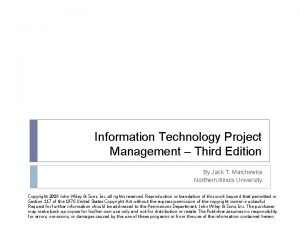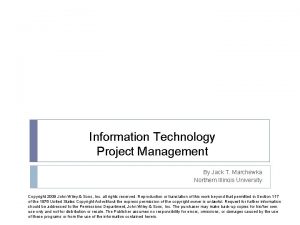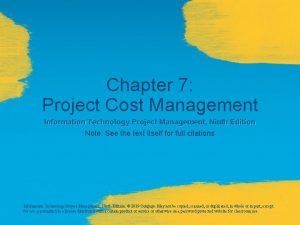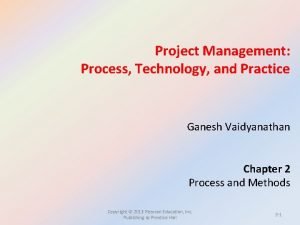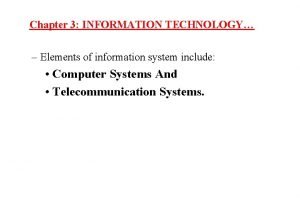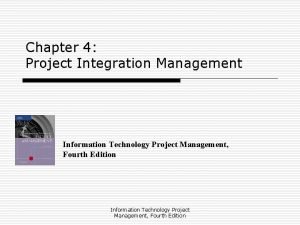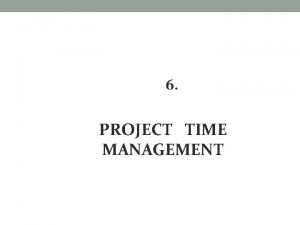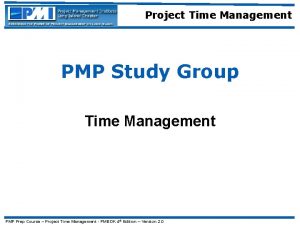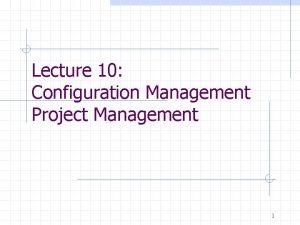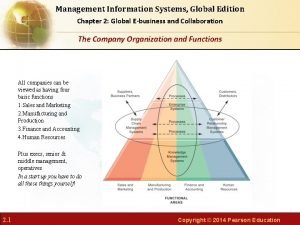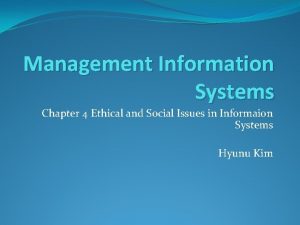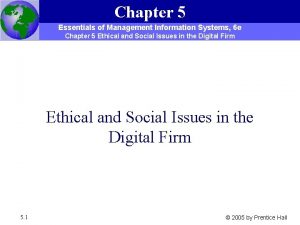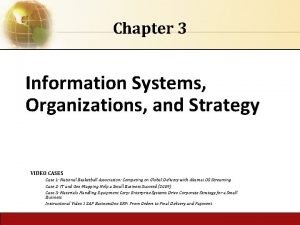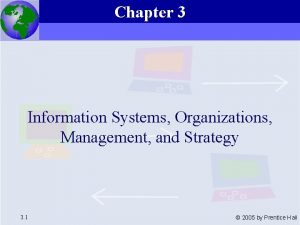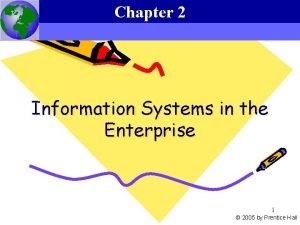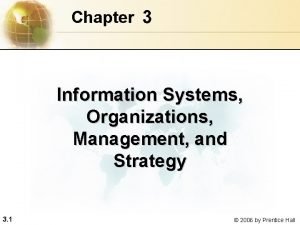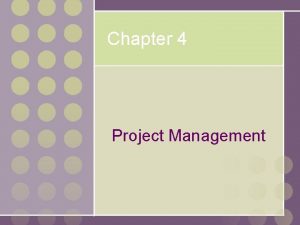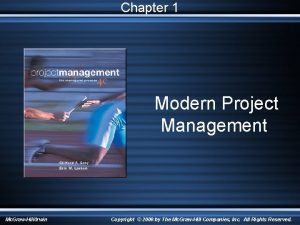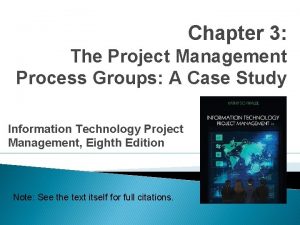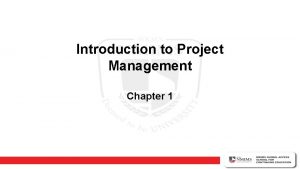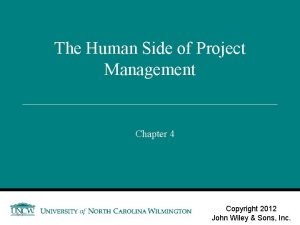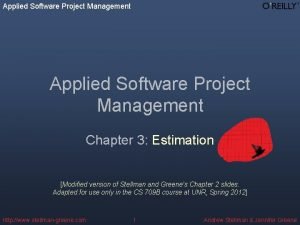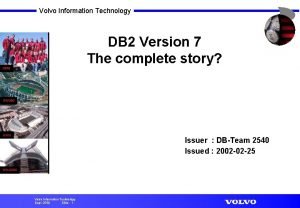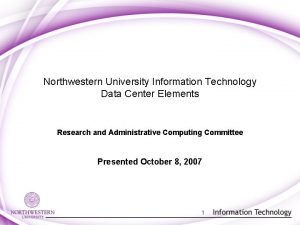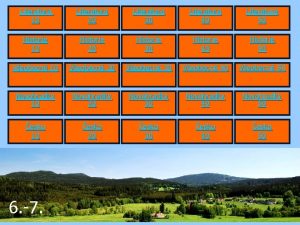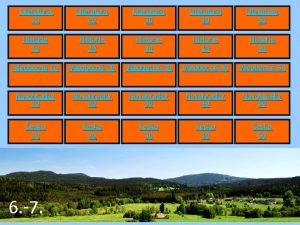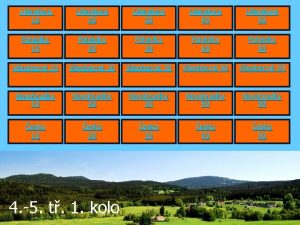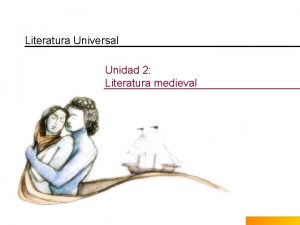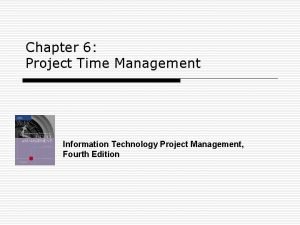Chapter 6 Project Time Management Literatura Information Technology





































































- Slides: 69

Chapter 6: Project Time Management Literatura: Information Technology Project Management, Seventh Edition

Rëndësia e planifikimit të projektit Menaxherët shpesh theksojnë se mbarimi i projekteve në kohën e paraparë paraqet një sfidë e vërtetë. Koha e ka sasinë më të vogël të fleksibilitetit, ajo kalon pavarësisht se çka ndodh në projekt Aspektet e planifikimit dhe koordinimit janë arsyet kryesore për konflikte në projekte, veçanërisht gjatë pjesës së dytë të projekteve 2 Project Time Management

Proceset në menaxhimin e kohës në projekte Definimi i aktivitetit: identifikimi i aktiviteteve të veçanta që anëtarët e ekipit të projektit dhe palët duhet ti ndërmarrin për të nxjerr produkte nga projekti Sekuencimi i aktivitetit: identifikimi dhe dokumentimi i raporteve ndërmjet aktiviteteve të projektit Vlerësimi i resurseve: vlerësimi për sasinë e resurseve që duhet të përdor ekipi i projektit për të realizuar aktivitetet e projektit Vlerësimi i zgjatjes së aktivitetit: vlerësimi i numrit të periudhave të punës që janë të nevojshme për të përfunduar një aktivitet individual Zhvillimi i planit: analiza i sekuencave të aktiviteteve, vlerësimi i resurseve të aktivitetit, dhe vlerësimi i zgjatjes së një aktiviteti për të krijuar planin e projektit Schedule control: kontrolli dhe menaxhimi i ndryshimeve gjatë planifikimit 3 Project Time Management

Përmbledhje për Menaxhimin Kohor në Projekt 4 Project Time Management

Definimi i aktivitetit Planet e projektit zhvillohen nga dokumentet themelore me të cilat nis projekti Skica e projektit (Project charter) e përfshin datat e nisjes dhe mbarimit dhe informacion mbi buxhetin Deklarata e shtrirjes (fushës) dhe WBS ndihmojnë në definimin e asaj çka do të realizohet Definimi i aktivitetit përfshin zhvillimin e WBS më të detajuara me sqarime për të kuptuar të gjithë punën me qëllim të krijimit të kostos së vërtet dhe vlerësimin e drejtë të kohëzgjatjes. 5 Project Time Management

Listat dhe atributet e aktivitetit Një list e aktivitetit është tabelë me aktivitete që përfshihet në planifikimin e projektit dhe përbëhet nga: Emri i aktivitetit Identifikuesi ose numri i aktivitetit Përshkrim i shkurtë për aktivitetin Atributet e aktivitetit japin më shumë informacione si paraardhësit, pasardhësit, relacionet logjike, kërkesat për resurse, kufizimet, datat e imponuara dhe supozimet që kanë të bëjnë me aktivitetin 6 Project Time Management

Ngjarjet e rëndësishme (Milestones) Një milestone është një ngjarje e rëndësishme që nuk ka kohëzgjatje Jo çdo produkt ose output i krijuar është milestone Shpesh duhen disa aktivitete dhe shumë punë që të kompletohet një milestone Ato janë vegla të dobishme për vendosjen e qëllimeve në plan dhe për monitorim të progresit Shembuj: kompletimi i produkteve specifike siç janë modulet softuerike ose instalimi i një hardueri të ri 7 Project Time Management

Sekuencimi i aktivitetit Pas definimit të aktiviteteve të projektit, hapi tjetër është sekuencimi Përfshin shqyrtimin e listës dhe atributeve të aktivitetit, deklarimit mbi fushën e zbatimit të projektit, listën e milestone-ve dhe miratimin e kërkesave për ndryshime për të përcaktuar raportet midis aktiviteteve Varshmëria ose relacioni paraqet sekuencimin (radhitjen) e aktiviteteve dhe veprimeve të projektit Duhet patjetër të përcaktohen varshmëritë për të 8 përdor analizën e rrugës kritike Project Time Management

Tre lloje të varshmërive Varshmëri të obligueshme: inherent in the nature of the work being performed on a project, sometimes referred to as hard logic Varshmëritë e lira (diskrecionale): të definuara nga ekimi i projektit; disa herë kjo quhet si soft logic dhe duhet të përdoret me kujdes pasi që më vonë mund ti kufizojnë opcionet e planifikimit Varshmëritë e jashtme: përfshin relacionet midis aktiviteteve që kanë të bëjnë me projektin dhe atyre që nuk kanë të bëjnë me projektet 9 Project Time Management

Diagramet Rrjetore Diagramet rrjetore janë teknika të preferuara për të treguar/ilustruar sekuencimin (rradhitjen) e aktiviteteve Një diagram rrjetor është paraqitje skematike e relacioneve logjike midis aktiviteteve në projekt Dy formate kryesore janë metodat diagramore me shigjeta dhe paraprirje 10 Project Time Management

Sample Activity-on-Arrow (AOA) Network Diagram për Projektin X 11 Project Time Management

Metoda e Diagramit me Shigjeta Arrow Diagramming Method (ADM) Quhet ndryshe edhe activity-on-arrow (AOA) diagrame rrjetore Aktivitetet paraqiten me shigjeta Nyjet ose rrathët janë pika filluese dhe mbaruese të aktiviteteve Mund të tregojnë vetëm varshmëritë finish-tostart Mund ti injorojnë aktivitetet që nuk kanë varshmëri 12 Project Time Management

Procesi për krijimin e AOA Diagrameve 1. Gjeji të gjitha aktivitetet që fillojnë në nyjën 1: Vizato nyjet e tyre të fundit dhe vizato shigjetat ndërmjet nyjës 1 dhe atyre nyjeve të përfundimtare; vendos shkronjë ose emër për aktivitetin si dhe vlerësimin për kohëzgjatjen në atë shigjetë 2. Vazhdo me vizatimin e diagramit rrjetor, duke punuar nga majtas djathtas: Shikoni shpërthimet dhe bashkimet Shpërthimet ndodhin kur nga një nyje dalin dy apo më shumë aktivitete Bashkimet ndodhin kur dy apo më shumë nyje i paraprijnë (bashkohen) një nyjeje 13 3. Vazhdo të vizatosh diagramin deri sa të gjitha aktivitetet që kanë varshmëri nuk janë përfshirë në diagram 4. Të gjitha kokat e shigjetave duhet të kahëzohen djathtas, dhe asnjë shigjetë nuk duhet të kalonjë në një diagram AOA Project Time Management

Metoda për Diagramet e Paraprirjes Precedence Diagramming Method (PDM) Është më i famshëm se ADM dhe përdoret nga softuerët për menaxhim projektesh Aktivitetet paraqiten me kuti Shigjetat i tregojnë relacionet midis aktiviteteve Është më i mirë për paraqitjen e tipeve të ndryshme të varshmërive 14 Project Time Management

Tipet për varshmërinë e veprimeve (task dependencies) 15 Project Time Management

Një Diagram PDM 16 Project Time Management

Vlerësimi i kohëzgjatjes së aktivitetit Kohëzgjatja përshinë sasinë aktuale të kohës efektive (koha e kaluar me punë) dhe kohës së kaluar Orvatja është numri i ditëve të punës ose orët e punës për ta përfunduar aktivitetin Orvatja nuk nënkupton kohëzgjatje 17 Project Time Management

Zhvillimi i Planifikimit Përdor rezultate të menaxhimit kohor të proceseve tjera për të përcaktuar fillimin dhe mbarimin e projektit Qëllimi final është të krijohet planifikim real që ofron bazën për monitorimin e progresit të projektit sa i përket dimensionit kohor Vegla dhe teknika të rëndësishme për këtë qëllim janë Gantt skemat, analiza e rrugës kritike - critical path analysis, planifikimi i zinxhirit kritik critical chain scheduling, dhe PERT analiza. 18 Project Time Management

Gantt Charts Gantt charts janë formate standarde për paraqitjen e informacionit e informacioneve mbi planifikimin e projektit duke listuar aktivitetet e projektit dhe datat përkatëse të aktiviteteve në formatin kalendarik Përdor këto simbole: Diamantet e zinj: milestone Shtylla të zeza (më të errëta): veprime përmbledhëse Shtylla më pak të errëta horizontale: kohëzgjatja e veprimit/aktivitetit Shigjetat: varshmëritë midis veprimeve 19 Project Time Management

Gantt Chart për Projektin X Shënim: Shtyllat më të errëta do jenë të kuqe në MS Project 20 Project Time Management

Gantt Chart për Projektin Software Launch 21 Project Time Management

Metoda e Rrugës Kritike - Critical Path Method (CPM) CPM është teknikë diagrami rrjetor që përdoret për parashikimin e kohëzgjatjes së përgjithshme të projektit Rruga kritike për projektin paraqet një seri me aktivitete që përcaktojnë kohën më të hershme sipas së cilës projekti mund të kompletohet Rruga kritike është rruga më e gjatë nëpër rrjet dhe ka sasinë më të vogël të kalimit (slack, float) Slack apo float përbën sasinë kohore që një aktivitet mund të vonohet por duke mos e vonuar një aktivitet pasardhës ose datën e kompletimit të projektit 22 Project Time Management

Determining the Critical Path for Project X 23 Project Time Management

More on the Critical Path A project team at Apple computer put a stuffed gorilla on the top of the cubicle of the person currently managing a critical task The critical path is not the one with all the critical activities; it only accounts for time Remember the example of growing grass being on the critical path for Disney’s Animal Kingdom There can be more than one critical path if the lengths of two or more paths are the same The critical path can change as the project progresses 24 Project Time Management

Using Critical Path Analysis to Make Schedule Trade-offs Free slack or free float is the amount of time an activity can be delayed without delaying the early start of any immediately following activities Total slack or total float is the amount of time an activity may be delayed from its early start without delaying the planned project finish date A forward pass through the network diagram determines the early start and finish dates A backward pass determines the late start and finish dates 25 Project Time Management

Calculating Early and Late Start and Finish Dates 26 Project Time Management

Free and Total Float or Slack for Project X 27 Project Time Management

Si gjendet rruga kritike General Foundry’s network with expected activity times A 2 C 2 F E 3 4 H Start 2 Finish B Figure 13. 3 3 D 4 G 5

How to Find the Critical Path 1. 2. 3. 4. To find the critical path, need to determine the following quantities for each activity in the network Earliest start time (ES): ES the earliest time an activity can begin without violation of immediate predecessor requirements Earliest finish time (EF): EF the earliest time at which an activity can end Latest start time (LS): LS the latest time an activity can begin without delaying the entire project Latest finish time (LF): LF the latest time an activity can end without delaying the entire project

How to Find the Critical Path In the nodes, the activity time and the early and late start and finish times are represented in the following manner ACTIVITY ES LS t EF LF Earliest times are computed as Earliest finish time = Earliest start time + Expected activity time EF = ES + t Earliest start = Largest of the earliest finish times of immediate predecessors ES = Largest EF of immediate predecessors

How to Find the Critical Path At the start of the project we set the time to zero Thus ES = 0 for both A and B A ES = 0 t=2 EF = 0 + 2 = 2 B ES = 0 t=3 EF = 0 + 3 = 3 Start

How to Find the Critical Path General Foundry’s ES and EF times A 0 2 2 C 2 2 4 F 4 E 4 Start B 0 Figure 13. 4 3 3 D 3 4 7 3 7 4 8 H 13 G 8 5 13 2 15 Finish

How to Find the Critical Path Latest times are computed as Latest start time = Latest finish time – Expected activity time LS = LF – t Latest finish time = Smallest of latest start times for following activities LF = Smallest LS of following activities For activity H LS = LF – t = 15 – 2 = 13 weeks

How to Find the Critical Path General Foundry’s LS and LF times A 0 0 2 2 2 C 2 2 2 4 4 F 4 10 E 4 4 Start B 0 1 Figure 13. 5 3 3 4 D 3 4 4 7 8 3 7 13 4 8 8 H 13 13 G 8 8 5 13 13 2 15 15 Finish

How to Find the Critical Path Once ES, LS, EF, and LF have been determined, it is a simple matter to find the amount of slack time that each activity has Slack = LS – ES, or Slack = LF – EF From Table 13. 3 we see activities A, C, E, G, and H have no slack time These are called critical activities and they are said to be on the critical path The total project completion time is 15 weeks Industrial managers call this a boundary timetable

How to Find the Critical Path General Foundry’s schedule and slack times ACTIVITY EARLIEST START, ES EARLIEST FINISH, EF LATEST START, LS LATEST FINISH, LF SLACK, LS – ES ON CRITICAL PATH? A 0 2 0 Yes B 0 3 1 4 1 No C 2 4 0 Yes D 3 7 4 8 1 No E 4 8 0 Yes F 4 7 10 13 6 No G 8 13 0 Yes H 13 15 0 Yes Table 13. 3

How to Find the Critical Path General Foundry’s critical path A 0 0 2 2 2 C 2 2 2 4 4 F 4 10 E 4 4 Start B 0 1 Figure 13. 6 3 3 4 D 3 4 4 7 8 3 7 13 4 8 8 H 13 13 G 8 8 5 13 13 2 15 15 Finish

Using the Critical Path to Shorten a Project Schedule Three main techniques for shortening schedules Shortening durations of critical activities/tasks by adding more resources or changing their scope Crashing activities by obtaining the greatest amount of schedule compression for the least incremental cost A 2 week task with one person working 50% could be shortened to 1 week if the person is assigned 100% no increase in cost Or, a temporary worker could be hired to work in parallel with the other worker to speed up the task (at a cost) 38

Project Crashing Projects will sometimes have deadlines that are impossible to meet using normal procedures By using exceptional methods it may be possible to finish the project in less time than normally required However, this usually increases the cost of the project Reducing a project’s completion time is called crashing

Project Crashing a project starts with using the normal time to create the critical path The normal cost is the cost for completing the activity using normal procedures If the project will not meet the required deadline, extraordinary measures must be taken The crash time is the shortest possible activity time and will require additional resources The crash cost is the price of completing the activity in the earlier-than-normal time

Four Steps to Project Crashing 1. Find the normal critical path and identify the critical activities 2. Compute the crash cost per week (or other time period) for all activities in the network using the formula Crash cost – Normal cost Crash cost/Time period = Normal time – Crash time

Four Steps to Project Crashing 3. 4. Select the activity on the critical path with the smallest crash cost per week and crash this activity to the maximum extent possible or to the point at which your desired deadline has been reached Check to be sure that the critical path you were crashing is still critical. If the critical path is still the longest path through the network, return to step 3. If not, find the new critical path and return to step 2.

General Foundry Example General Foundry has been given 14 weeks instead of 16 weeks to install the new equipment The critical path for the project is 15 weeks What options do they have? The normal and crash times and costs are shown in Table 13. 9 Crash costs are assumed to be linear and Figure 13. 11 shows the crash cost for activity B Crashing activity A will shorten the completion time to 14 but it creates a second critical path B, D, G, H because when you recalculate the LF and LS times for B and D they now match the EF and ES Any further crashing must be done to both critical paths

General Foundry Example Normal and crash data for General Foundry TIME (WEEKS) COST ($) ACTIVITY NORMAL CRASH COST PER WEEK ($) CRITICAL PATH? A 2 1 22, 000 23, 000 1, 000 Yes B 3 1 30, 000 34, 000 2, 000 No C 2 1 26, 000 27, 000 1, 000 Yes D 4 3 48, 000 49, 000 1, 000 No E 4 2 56, 000 58, 000 1, 000 Yes F 3 2 30, 000 30, 500 No G 5 2 80, 000 86, 000 2, 000 Yes H 2 1 16, 000 19, 000 3, 000 Yes Table 13. 9

General Foundry Example Crash and normal times and costs for activity B Activity Cost Crash Cost/Week = $34, 000 – Crash Cost – Normal Cost Normal Time – Crash Time $34, 000 – $30, 000 3– 1 $4, 000 = = $2, 000/Week 2 Weeks $33, 000 – = $32, 000 – $31, 000 – Normal $30, 000 – Normal Cost – | 0 Figure 13. 11 | 1 Crash Time | 2 | 3 Normal Time (Weeks)

Using the Critical Path to Shorten a Project Schedule Fast tracking activities by doing them in parallel or overlapping them instead of doing them in sequence Instead of waiting for all analysis to be completed before starting coding, some coding could begin for those tasks that have been fully analyzed Drawback – starting a task too soon could lengthen the project because other tasks whose analysis has not been completed could impact this task and cause rework 46 Project Time Management

Importance of Updating Critical Path Data It is important to update project schedule information to meet time goals for a project The critical path may change as you enter actual start and finish dates If you know the project completion date will slip, be proactive and negotiate with the project sponsor and stakeholders 47 Project Time Management

Critical Chain Scheduling Critical chain scheduling A method of scheduling that considers limited resources when creating a project schedule and includes buffers to protect the project completion date Based on the Theory of Constraints (TOC) A management philosophy developed by Eli Goldratt and introduced in his book The Goal and Critical Chain Like a chain with its weakest link, any complex system at any point in time often has only one aspect or constraint that limits ability to achieve more of its goal For the system to attain any significant improvements, that constraint must be identified and the whole system must be managed with it in mind For example, two tasks originally scheduled to be done in parallel, require the same resource 100% of the time. CCS acknowledges that either one of the tasks must be delayed or a similar resource must be found in order to keep to the original schedule 48 Project Time Management

Critical Chain Scheduling Attempts to minimize multitasking When a resource works on more than one task at a time – people are assigned to multiple tasks within the same project or different tasks on multiple projects Someone assigned to three tasks, tries to please everyone and works a little on each task and then goes back to finish the first one This can actually delay the completion of tasks as compared to working on each task in sequence Multitasking also often involves wasted setup time, which increases total duration 49 Project Time Management

Multitasking Example 50 Project Time Management

Critical Chain Scheduling Critical Chain Project Management (CCPM), developed by Eliyahu M. Goldratt, is a method of planning and managing projects that puts more emphasis on the resources required to execute project tasks. This is in contrast to the more traditional Critical Path and PERT methods, which emphasize task order and rigid scheduling. A Critical Chain project network will tend to keep the resources levelly loaded, but will require them to be flexible in their start times and to quickly switch between tasks and task chains to keep the whole project on schedule. Typically, CCPM case studies report 95% on-time and on- budget completion when CCPM is applied correctly. 51 Project Time Management

Buffers and Critical Chain In traditional estimates, people often add a buffer to each task and use it if it’s needed or not A buffer is additional time to complete a task This time is added to when there is multitasking, distractions, interruptions, fear that estimates will be reduced and Murphy’s Law states that if something can go wrong, it will 52 Project Time Management

Buffers and Critical Chain Critical chain scheduling removes buffers from individual tasks and instead creates: A project buffer or additional time added before the project’s due date Feeding buffers or additional time added before tasks on the critical path that are preceded by non-critical-path tasks The tasks estimates in critical chain scheduling should be shorter than traditional estimates because they do not include their own buffers Not having tasks buffers should mean less occurrence of Parkinson’s Law - work expands to fill the time allowed Feeding and project buffers protect the date that really needs to be met – the project completion date 53 Project Time Management

Example of Critical Chain Scheduling 54 Project Time Management

Example of Critical Chain Scheduling Critical Path = Task 1+Task 2+Task 3+ Lag+ Task 6 = 5+4+2+1+8 = 21 Days. 55 Project Time Management

Example of Critical Chain Scheduling Critical Path = Task 1+Task 2+Task 3+ Lag+ Task 6 = 5+4+2+1+8 = 21 Days. 56 Project Time Management

Example of Critical Chain Scheduling 57 Remove safety time and reduce tasks durations by 50%. Project Duration = Task 1+Task 2+Task 3+ Task 6 = 3+2+1+4 = 10 Days. Note: • All safety time durations are removed. For example 1 day lag after Task 2 and 4 days after Task 5 are removed. • All tasks durations are reduced to half (50%). For example Task 1 is 3 Days instead of 6 days. Project Time Management

Example of Critical Chain Scheduling 58 Create schedule on Late Finish dates and Remove resource constraints and identify critical chain. Project Duration = Task 1+Task 2+Task 5+ Task 6 = 3+2+2+4 = 11 Days. Note: • Task 3, Task 4 and Task 5 are moved to start from Late Finish dates. • Task 2 and Task 5 are to be done by resource R 2 and so that aligned to remove resource constraints. Project Time Management

Example of Critical Chain Scheduling Add Project Buffer of 50% of the tasks duration and add Feeder buffer to non critical chain. Project Duration = Task 1+Task 2+Task 5+ Task 6 + PB = 3+2+2+4+5 = 16 Days. Note: • Project Buffer (PB) = 50% of Project Duration (11 Days) = 5. 5 Days = 5 Days (Rounded). • Feeder Buffer (FB) for non critical tasks on chain. For example Task 4 is added 2 days FB. 59 Project Time Management

Comparison of CPM and CCPM results According to the results we found above, project duration by CPM traditional approach is 21 days and the project duration for the same amount of work by using CCPM is 16 Days. Using CCPM: Project Duration can be reduced by 25 -40%. Resources can be utilized effectively. Project is fully focused on both critical and non critical tasks

Program Evaluation and Review Technique (PERT) PERT is a network analysis technique used to estimate project duration when there is a high degree of uncertainty about the individual activity duration estimates PERT uses probabilistic time estimates Duration estimates based on using optimistic, most likely, and pessimistic estimates of activity durations, or a three-point estimate PERT attempts to address the risk associated with duration estimates by developing schedules that are more realistic It involves more work than CPM since it requires several duration estimates 61 Project Time Management

PERT Formula and Example PERT weighted average = optimistic time + 4 X most likely time + pessimistic time 6 Example: PERT weighted average = 8 workdays + 4 X 10 workdays + 24 workdays = 12 days 6 where optimistic time= 8 days, most likely time = 10 days, and pessimistic time = 24 days Therefore, you’d use 12 days on the network diagram instead of 10 when using PERT for the above example 62 Project Time Management

Schedule Control Perform reality checks on schedules Allow for contingencies Don’t plan for everyone to work at 100% capacity all the time Hold progress meetings with stakeholders and be clear and honest in communicating schedule issues 63 Project Time Management

Schedule Control (continued) Goals are to know the status of the schedule, influence factors that cause schedule changes, determine that the schedule has changed, and manage changes when they occur Tools and techniques include: Progress reports A schedule change control system Project management software, including schedule comparison charts like the tracking Gantt chart Variance analysis, such as analyzing float or slack Performance management, such as earned value (chapter 7) 64 Project Time Management

Reality Checks on Scheduling First review the draft schedule or estimated completion date in the project charter Prepare a more detailed schedule with the project team Make sure the schedule is realistic and followed Alert top management well in advance if there are schedule problems Verify schedule progress – just because a team member says a task was completed on time doesn’t always mean that it was 65 Project Time Management

Working with People Issues Strong leadership helps projects succeed more than good PERT charts Project managers should use: Empowerment Incentives Discipline Negotiation 66 Project Time Management

What Went Right? Chris Higgins used the discipline he learned in the U. S. Army to transform project management into a cultural force at Bank of America; he used the same approach he did for packing tents when he led an interstate banking initiative He made the team members analyze, plan, and document requirements for the system in such detail that it took six months just to complete that phase However, because of his discipline with time management and planning, the software developers on the team finished all of the coding in only three months, and the project was completed on time* *Melymuke, Kathleen, “Spit and Polish, ” Computer. World (February 16, 1998). 67 Project Time Management

Using Software to Assist in Time Management Software for facilitating communications helps people exchange schedule-related information Decision support models help analyze trade-offs that can be made Project management software can help in various time management areas 68 Project Time Management

Words of Caution on Using Project Management Software Many people misuse project management software because they don’t understand important concepts and have not had training You must enter dependencies to have dates adjust automatically and to determine the critical path You must enter actual schedule information to compare planned and actual progress 69 Project Time Management
 Information technology project management 9th edition
Information technology project management 9th edition Blue project chapter 5
Blue project chapter 5 Information technology project management 8th edition
Information technology project management 8th edition Project management chapter 6
Project management chapter 6 Information technology project management 9th edition
Information technology project management 9th edition Information technology project management
Information technology project management Information technology project management
Information technology project management Importance of software project management
Importance of software project management Definitive estimate range
Definitive estimate range Enterprise and global management
Enterprise and global management Managing information technology resources
Managing information technology resources Crm and information technology
Crm and information technology Project management process technology and practice
Project management process technology and practice Information technology chapter 3
Information technology chapter 3 Chapter 1 information technology the internet and you
Chapter 1 information technology the internet and you Chapter 1 information technology the internet and you
Chapter 1 information technology the internet and you What is elapsed time
What is elapsed time Project management for information security
Project management for information security Project management information system example
Project management information system example Project management information system example
Project management information system example The role of project management in achieving project success
The role of project management in achieving project success Modern project profiles in software project management
Modern project profiles in software project management Reducing project duration examples
Reducing project duration examples Modern project management began with what project
Modern project management began with what project Software project evaluation
Software project evaluation Types of project audit in project management
Types of project audit in project management Microsoft project agile template
Microsoft project agile template Project termination types
Project termination types Time management project
Time management project Project time management processes
Project time management processes Pmbok time management
Pmbok time management Project crashing template
Project crashing template Asset management vs project management
Asset management vs project management Configuration management system pmp
Configuration management system pmp Basic principles of cost management
Basic principles of cost management Software configuration management diagram
Software configuration management diagram What is project integration management
What is project integration management Time management human resources
Time management human resources Management information system chapter 2
Management information system chapter 2 Mis chapter 3
Mis chapter 3 Management information system chapter 4
Management information system chapter 4 Mis chapter 1
Mis chapter 1 Chapter 9 information management and security
Chapter 9 information management and security Management information system chapter 5
Management information system chapter 5 Management information system chapter 5
Management information system chapter 5 Introduction management information system
Introduction management information system Management information system chapter 5
Management information system chapter 5 Management information system chapter 3
Management information system chapter 3 Management information system chapter 3
Management information system chapter 3 Management information system chapter 2
Management information system chapter 2 Chapter 15 using management and accounting information
Chapter 15 using management and accounting information Management information system chapter 3
Management information system chapter 3 Chapter 3 project management
Chapter 3 project management A series of coordinated related multiple projects
A series of coordinated related multiple projects Project management chapter 4
Project management chapter 4 Chapter 4 project integration management
Chapter 4 project integration management Modern project management
Modern project management Project management chapter 3
Project management chapter 3 Project management chapter 1
Project management chapter 1 Human side of project management
Human side of project management Project management chapter 3
Project management chapter 3 Positive impacts of material technology
Positive impacts of material technology Negative impacts of environmental technology
Negative impacts of environmental technology Volvo information technology
Volvo information technology User acceptance of information technology
User acceptance of information technology Conclusion of communication technology
Conclusion of communication technology Similarities of media information and technology literacy
Similarities of media information and technology literacy Northwestern university information technology
Northwestern university information technology 5 disadvantages of information technology
5 disadvantages of information technology Information technology introduction
Information technology introduction





